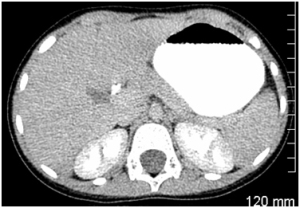by
Astrid Fiano, DOTmed News Writer | November 30, 2009

An abdominal CT of
a pediatric patient in
which the imaging
protocol consisted of
a delayed phase
A new study just presented during the annual meeting of the Radiological Society of North America (RSNA) indicates a significant portion of patients undergoing abdominal/pelvic computed tomography (CT) receive unindicated additional image acquisition that results in excess and avoidable radiation exposure.
The study is entitled "Excess Radiation Exposure in Abdominal Computed Tomography: An Audit of Unindicated Additional Series." According to the abstract of the study, the research was undertaken in light of current media concern about excess medical radiation, particularly with CT usage. The study focused on a particular area not examined previously: excess radiation related to additional series (such as routine non-contrast or delayed scans). The study set out to determine the frequency of unindicated additional scanning and the resultant excess radiation exposure.
CT exams image a patient using a CT scanner and may involve injection of an intravenous contrast agent. Each image taken is known as a series. Generally multiple series are not necessary except for certain conditions.



Ad Statistics
Times Displayed: 2839
Times Visited: 27 Fast-moving cardiac structures have a big impact on imaging. Fujifilm’s SCENARIA View premium performance CT brings solutions to address motion in Coronary CTA while delivering unique dose saving and workflow increasing benefits.
The study involved 978 series for 500 patients, in age range from nine months to 91 years, with most between 30 and 50 years old. The results found unindicated series in 52.2% of exams, or 35.3% of all series. The most common series was delayed phase imaging in 77.7% of the unnecessary series. The mean total radiation dose per patient from unnecessary scans was 11.3 millisieverts. Extrapolation of the mean dose over the total number of abdomen/pelvis CT scans performed in the U.S. yearly would result in an excess lifetime attributable risk of 0.1% for those patients undergoing an abdomen/pelvis CT exams. The practice of adding such series is common, but the study concludes a potential public health danger exists without any balance of associated clinical benefit.
"It is the responsibility of all physicians who work with ionizing radiation to ensure that the dosage is as low as reasonably achievable without compromising the patient's well being," said presenter Kristie Guite, M.D., radiology resident at the University of Wisconsin (UW) in Madison, in an RSNA press release. "Our study found that this principle is not being followed in many practices."
"We suspect that at many institutions there is a lack of focus on selecting CT protocols tailored specifically to answer the clinical question," said coauthor J. Louis Hinshaw, M.D., assistant professor of radiology at UW - Madison. "It is certainly easier to select an 'every size fits all' approach."

